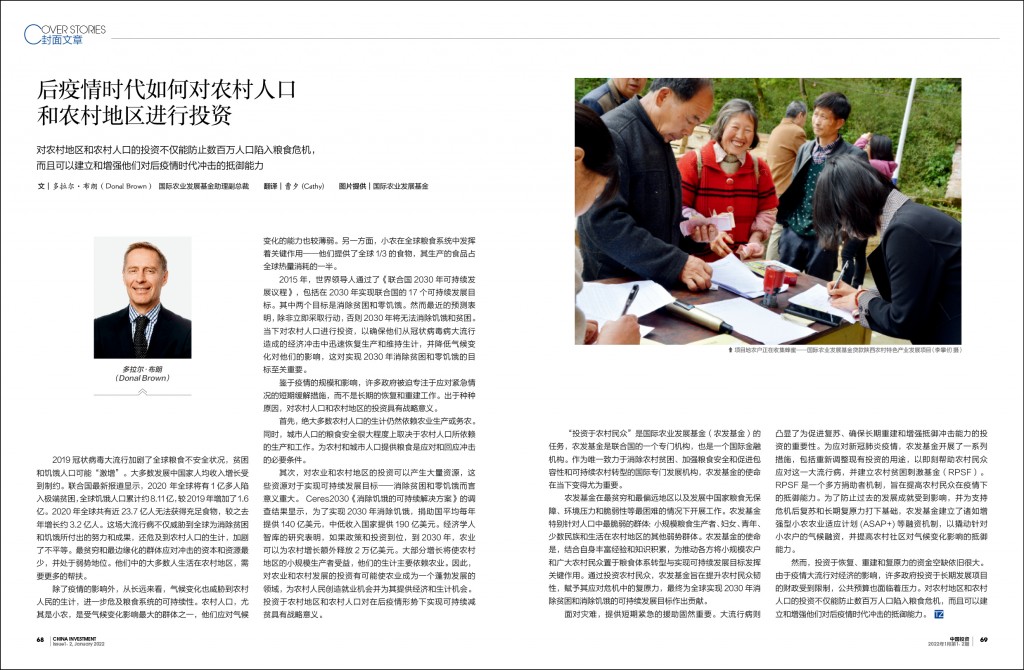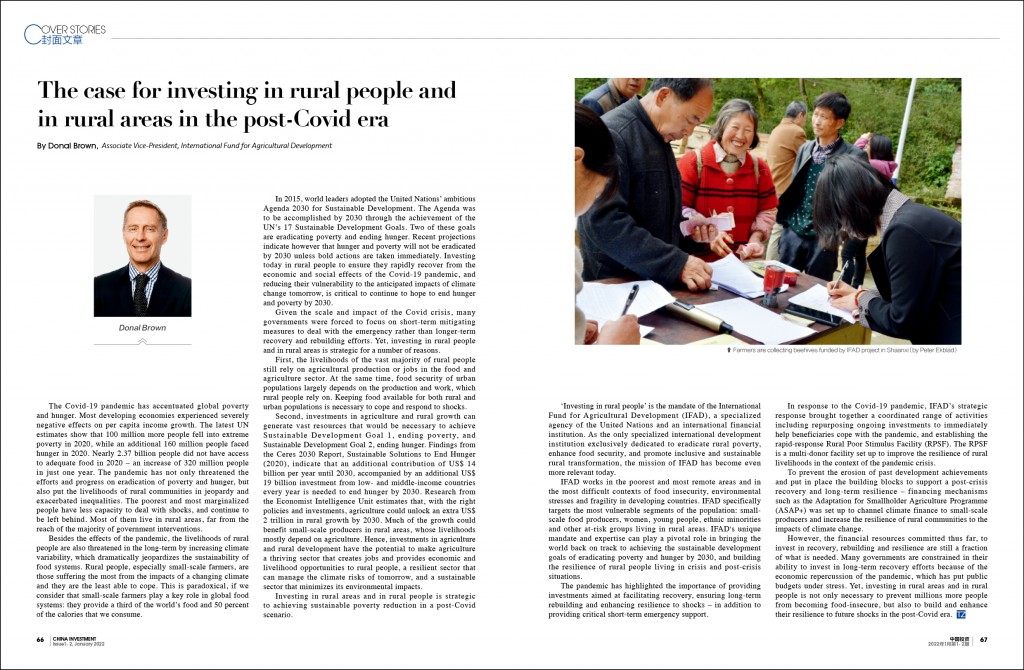
1月封面文章
2022展望
By Donal Brown, Associate Vice-President, International Fund for Agricultural Development
文|多拉尔·布朗(Donal Brown) 国际农业发展基金助理副总裁
导读
The case for investing in rural people and in rural areas in the post-Covid era
The Covid-19 pandemic has accentuated global poverty and hunger. Most developing economies experienced severely negative effects on per capita income growth. The latest UN estimates show that 100 million more people fell into extreme poverty in 2020, while an additional 160 million people faced hunger in 2020. Nearly 2.37 billion people did not have access to adequate food in 2020 – an increase of 320 million people in just one year. The pandemic has not only threatened the efforts and progress on eradication of poverty and hunger, but also put the livelihoods of rural communities in jeopardy and exacerbated inequalities. The poorest and most marginalized people have less capacity to deal with shocks, and continue to be left behind. Most of them live in rural areas, far from the reach of the majority of government interventions.
⬆ Farmers are collecting beehives funded by IFAD project in Shaanxi(by Peter Ekblad)
Besides the effects of the pandemic, the livelihoods of rural people are also threatened in the long-term by increasing climate variability, which dramatically jeopardizes the sustainability of food systems. Rural people, especially small-scale farmers, are those suffering the most from the impacts of a changing climate and they are the least able to cope. This is paradoxical, if we consider that small-scale farmers play a key role in global food systems: they provide a third of the world’s food and 50 percent of the calories that we consume.
In 2015, world leaders adopted the United Nations’ ambitious Agenda 2030 for Sustainable Development. The Agenda was to be accomplished by 2030 through the achievement of the UN’s 17 Sustainable Development Goals. Two of these goals are eradicating poverty and ending hunger. Recent projections indicate however that hunger and poverty will not be eradicated by 2030 unless bold actions are taken immediately. Investing today in rural people to ensure they rapidly recover from the economic and social effects of the Covid-19 pandemic, and reducing their vulnerability to the anticipated impacts of climate change tomorrow, is critical to continue to hope to end hunger and poverty by 2030.
Given the scale and impact of the Covid crisis, many governments were forced to focus on short-term mitigating measures to deal with the emergency rather than longer-term recovery and rebuilding efforts. Yet, investing in rural people and in rural areas is strategic for a number of reasons.
First, the livelihoods of the vast majority of rural people still rely on agricultural production or jobs in the food and agriculture sector. At the same time, food security of urban populations largely depends on the production and work, which rural people rely on. Keeping food available for both rural and urban populations is necessary to cope and respond to shocks.
Second, investments in agriculture and rural growth can generate vast resources that would be necessary to achieve Sustainable Development Goal 1, ending poverty, and Sustainable Development Goal 2, ending hunger. Findings from the Ceres 2030 Report, Sustainable Solutions to End Hunger (2020), indicate that an additional contribution of US$ 14 billion per year until 2030, accompanied by an additional US$ 19 billion investment from low- and middle-income countries every year is needed to end hunger by 2030. Research from the Economist Intelligence Unit estimates that, with the right policies and investments, agriculture could unlock an extra US$ 2 trillion in rural growth by 2030. Much of the growth could benefit small-scale producers in rural areas, whose livelihoods mostly depend on agriculture. Hence, investments in agriculture and rural development have the potential to make agriculture a thriving sector that creates jobs and provides economic and livelihood opportunities to rural people, a resilient sector that can manage the climate risks of tomorrow, and a sustainable sector that minimizes its environmental impacts.
Investing in rural areas and in rural people is strategic to achieving sustainable poverty reduction in a post-Covid scenario.
‘Investing in rural people’ is the mandate of the International Fund for Agricultural Development (IFAD), a specialized agency of the United Nations and an international financial institution. As the only specialized international development institution exclusively dedicated to eradicate rural poverty, enhance food security, and promote inclusive and sustainable rural transformation, the mission of IFAD has become even more relevant today.
IFAD works in the poorest and most remote areas and in the most difficult contexts of food insecurity, environmental stresses and fragility in developing countries. IFAD specifically targets the most vulnerable segments of the population: small-scale food producers, women, young people, ethnic minorities and other at-risk groups living in rural areas. IFAD’s unique mandate and expertise can play a pivotal role in bringing the world back on track to achieving the sustainable development goals of eradicating poverty and hunger by 2030, and building the resilience of rural people living in crisis and post-crisis situations.
The pandemic has highlighted the importance of providing investments aimed at facilitating recovery, ensuring long-term rebuilding and enhancing resilience to shocks – in addition to providing critical short-term emergency support.
In response to the Covid-19 pandemic, IFAD’s strategic response brought together a coordinated range of activities including repurposing ongoing investments to immediately help beneficiaries cope with the pandemic, and establishing the rapid-response Rural Poor Stimulus Facility (RPSF). The RPSF is a multi-donor facility set up to improve the resilience of rural livelihoods in the context of the pandemic crisis.
To prevent the erosion of past development achievements and put in place the building blocks to support a post-crisis recovery and long-term resilience – financing mechanisms such as the Adaptation for Smallholder Agriculture Programme (ASAP+) was set up to channel climate finance to small-scale producers and increase the resilience of rural communities to the impacts of climate change.
However, the financial resources committed thus far, to invest in recovery, rebuilding and resilience are still a fraction of what is needed. Many governments are constrained in their ability to invest in long-term recovery efforts because of the economic repercussion of the pandemic, which has put public budgets under stress. Yet, investing in rural areas and in rural people is not only necessary to prevent millions more people from becoming food-insecure, but also to build and enhance their resilience to future shocks in the post-Covid era.

2019冠状病毒大流行加剧了全球粮食不安全状况,贫困和饥饿人口可能“激增”。大多数发展中国家人均收入增长受到制约。联合国最新报道显示,2020 年全球将有1亿多人陷入极端贫困,全球饥饿人口累计约8.11亿,较2019年增加了1.6亿。2020年全球共有近23.7亿人无法获得充足食物,较之去年增长约3.2亿人。这场大流行病不仅威胁到全球为消除贫困和饥饿所付出的努力和成果,还危及到农村人口的生计,加剧了不平等。最贫穷和最边缘化的群体应对冲击的资本和资源最少,并处于弱势地位。他们中的大多数人生活在农村地区,需要更多的帮扶。
除了疫情的影响外,从长远来看,气候变化也威胁到农村人民的生计,进一步危及粮食系统的可持续性。农村人口,尤其是小农,是受气候变化影响最大的群体之一,他们应对气候变化的能力也较薄弱。另一方面,小农在全球粮食系统中发挥着关键作用——他们提供了全球1/3的食物,其生产的食品占全球热量消耗的一半。
⬆ 项目地农户正在收集蜂蜜——国际农业发展基金贷款陕西农村特色产业发展项目(李攀仞 摄)
2015年,世界领导人通过了《联合国2030年可持续发展议程》,包括在2030年实现联合国的17个可持续发展目标。其中两个目标是消除贫困和零饥饿。然而最近的预测表明,除非立即采取行动,否则2030年将无法消除饥饿和贫困。当下对农村人口进行投资,以确保他们从冠状病毒病大流行造成的经济冲击中迅速恢复生产和维持生计,并降低气候变化对他们的影响,这对实现2030年消除贫困和零饥饿的目标至关重要。
鉴于疫情的规模和影响,许多政府被迫专注于应对紧急情况的短期缓解措施,而不是长期的恢复和重建工作。出于种种原因,对农村人口和农村地区的投资具有战略意义。
首先,绝大多数农村人口的生计仍然依赖农业生产或务农。同时,城市人口的粮食安全很大程度上取决于农村人口所依赖的生产和工作。为农村和城市人口提供粮食是应对和回应冲击的必要条件。
其次,对农业和农村地区的投资可以产生大量资源,这些资源对于实现可持续发展目标——消除贫困和零饥饿而言意义重大。 Ceres2030《消除饥饿的可持续解决方案》的调查结果显示,为了实现2030年消除饥饿,捐助国平均每年提供140亿美元,中低收入国家提供190亿美元。经济学人智库的研究表明,如果政策和投资到位,到2030年,农业可以为农村增长额外释放2万亿美元。大部分增长将使农村地区的小规模生产者受益,他们的生计主要依赖农业。因此,对农业和农村发展的投资有可能使农业成为一个蓬勃发展的领域,为农村人民创造就业机会并为其提供经济和生计机会。投资于农村地区和农村人口对在后疫情形势下实现可持续减贫具有战略意义。
“投资于农村民众”是国际农业发展基金(农发基金)的任务,农发基金是联合国的一个专门机构,也是一个国际金融机构。作为唯一致力于消除农村贫困、加强粮食安全和促进包容性和可持续农村转型的国际专门发展机构,农发基金的使命在当下变得尤为重要。
农发基金在最贫穷和最偏远地区以及发展中国家粮食无保障、环境压力和脆弱性等最困难的情况下开展工作。农发基金特别针对人口中最脆弱的群体:小规模粮食生产者、妇女、青年、少数民族和生活在农村地区的其他弱势群体。农发基金的使命是,结合自身丰富经验和知识积累,为推动各方将小规模农户和广大农村民众置于粮食体系转型与实现可持续发展目标发挥关键作用。通过投资农村民众,农发基金旨在提升农村民众韧性,赋予其应对危机中的复原力,最终为全球实现2030年消除贫困和消除饥饿的可持续发展目标作出贡献。
面对灾难,提供短期紧急的援助固然重要。大流行病则凸显了为促进复苏、确保长期重建和增强抵御冲击能力的投资的重要性。为应对新冠肺炎疫情,农发基金开展了一系列措施,包括重新调整现有投资的用途,以即刻帮助农村民众应对这一大流行病,并建立农村贫困刺激基金(RPSF)。RPSF是一个多方捐助者机制,旨在提高农村民众在疫情下的抵御能力。为了防止过去的发展成就受到影响,并为支持危机后复苏和长期复原力打下基础,农发基金建立了诸如增强型小农农业适应计划(ASAP+)等融资机制,以撬动针对小农户的气候融资,并提高农村社区对气候变化影响的抵御能力。
然而,投资于恢复、重建和复原力的资金空缺依旧很大。由于疫情大流行对经济的影响,许多政府投资于长期发展项目的财政受到限制,公共预算也面临着压力。对农村地区和农村人口的投资不仅能防止数百万人口陷入粮食危机,而且可以建立和增强他们对后疫情时代冲击的抵御能力。
编辑 | 伊 南
翻译 | 曹 夕
校对 | 闫建军
设计 | 大 米



